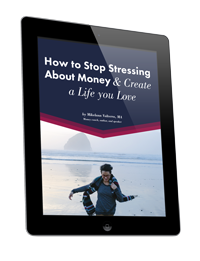Many of my clients grapple with the idea of home ownership and how much buying a house will really cost them. I am not a mortgage broker or real estate agent, so when Zillow asked if I would like an article on this exact subject, I happily accepted. Buying my own home after my divorce was one of the biggest things I ever did in the realm of money. And of course my house continues to cost me money in terms of maintenance and my mortgage. But it also gives me great joy, a sense of security and is one important piece of my net worth.
 I build my mortgage payment into my monthly spending plan and on-going maintenance and improvements are part of my annual spending plan. (Before I bought my house I had a category called “house down payment” in my spending plan, where I saved money each month in preparation to buy my sweet home.)
I build my mortgage payment into my monthly spending plan and on-going maintenance and improvements are part of my annual spending plan. (Before I bought my house I had a category called “house down payment” in my spending plan, where I saved money each month in preparation to buy my sweet home.)
4 Major Costs to Evaluate When Considering Homeownership
By Jay Robert
Typically, a home is the most expensive purchase a consumer will make in his or her lifetime. Therefore, the decision-making process should be well researched prior to accepting the financial responsibilities of purchasing and owning a home. Mortgage choices made early on in the buying process affect the total cost of homeownership by thousands or even tens of thousands of dollars throughout the life of the loan, so it’s advantageous to be informed from the start. Here are four major costs home shoppers should evaluate before buying a home.
1. Interest rate and length of loan term
Consumers considering obtaining a mortgage to buy a home should raise their credit scores as high as possible, as credit scores impact the interest rates offered by lenders and ultimately affect the total cost of the loan. Credit scores range from 300 (poor) to 850 (excellent), and lenders generally offer consumers with higher credit scores lower interest rates. Typically borrowers with scores of 740 or higher receive the best interest rates, and even scores of 660 qualify for conventional home loans, though cutoff points vary from lender to lender. Low scores can be improved by paying bills on time, paying down debts and avoiding opening new credit lines before applying for loans.
Next, consumers should begin shopping for reputable lenders who offer low interest rates. While a percentage point difference in interest rates might not seem significant, over the life of the loan it can cost tens of thousands of dollars. For example, consumers who borrow $300,000 over 30 years at 5 percent pay $65,000 more in interest over the life of the loan than someone with a 4 percent interest rate.
Another way to lower the interest rate on a mortgage is to shorten the term of the loan. Borrowers pay more each month, but the shortened length of the loan reduces total interest. A $300,000 loan at 4 percent paid off over 15 years costs the borrower roughly $100,000 in interest, compared with more than $215,000 in interest if that same loan is paid off over 30 years.
2. Down payment and closing costs
Home buyers must be prepared to pay both a down payment and closing costs associated with buying a home. The down payment is typically 10 to 20 percent of the home price; so a $200,000 home might require a $20,000 to $40,000 down payment.
Closing costs are charged to borrowers for credit reports, inspections, appraisal costs, discount points to lower interest rates and attorney and lender fees. In general, closing costs tend to range between 2 percent and 5 percent of the purchase price of the home.
3. Monthly costs
The monthly costs of homeownership exceed the monthly mortgage payment. The cost of homeownership includes the mortgage payments (principal and interest), taxes, condo or homeowners association (HOA) fees and insurance, including homeowners insurance, private mortgage insurance (PMI) and other supplemental policies such as flood insurance. Some experts recommend the total monthly costs not exceed 25 percent of a homeowner’s monthly income. Some lenders advise capping costs at 35 percent. Home buyers should evaluate their level of comfort and financial security before making this decision, because putting down more than 30 percent may lead buyers into debt; after making mortgage payments they may not have enough money left to support their lifestyles.
4. Repairs and maintenance
In addition to mortgage payments, taxes, insurance and condo association fees, homeowners are also responsible for maintenance and repairs on their homes. After placing an offer on a home, the buyers pay for a thorough inspection to determine necessary repairs and then negotiate with the seller to get them fixed before closing. Once purchased, experts suggest budgeting between 1 percent and 2 percent of the purchase price of the home each year to cover home maintenance. For example, a homeowner with a $200,000 home would need to save $2,000 to $3,000 annually for maintenance and repairs.
To minimize the cost of buying a home, buyers should raise their credit scores, look for low interest rates from reputable lenders and compare lenders’ closing costs. Home buyers should establish how much home they can afford while living a comfortable lifestyle before home shopping. Keep in mind closing costs and down payments are only the initial payments, and buyers are still responsible for the monthly costs of mortgage payments, taxes, insurance, fees and standard maintenance of the property. Although owning a home is an enduring American dream, the financial burden can be challenging and isn’t as straight-forward as a monthly mortgage payment.
Want more help transforming your relationship to money? Check out all the eBooks, audios, and more robust products Mikelann has created. Are you ready to break free of the “money fog” and step into earning what you are worth? Are you are ready to get in touch with your emotions so you never feel out of control around money again? Are you ready to love your financial life? Let Mikelann help you get there. Free items are at the top of the page.

